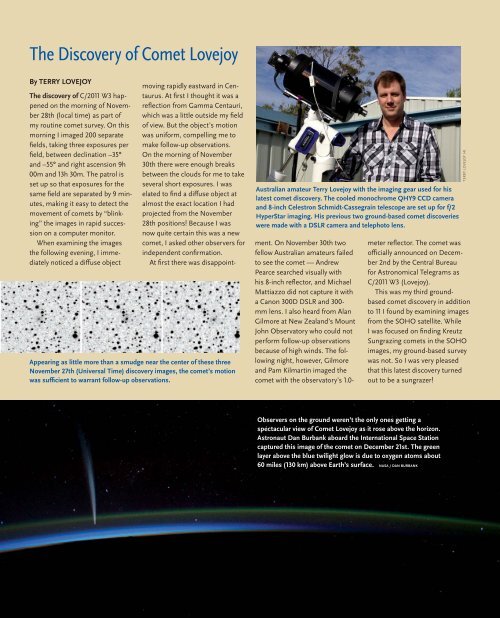Download this ebook as PDF - E-Book Library
Download this ebook as PDF - E-Book Library
Download this ebook as PDF - E-Book Library
Create successful ePaper yourself
Turn your PDF publications into a flip-book with our unique Google optimized e-Paper software.
The Discovery of Comet Lovejoy<br />
By TERRY LOVEJOY<br />
The discovery of C/2011 W3 happened<br />
on the morning of November<br />
28th (local time) <strong>as</strong> part of<br />
my routine comet survey. On <strong>this</strong><br />
morning I imaged 200 separate<br />
fi elds, taking three exposures per<br />
fi eld, between declination –35°<br />
and –55° and right <strong>as</strong>cension 9h<br />
00m and 13h 30m. The patrol is<br />
set up so that exposures for the<br />
same fi eld are separated by 9 minutes,<br />
making it e<strong>as</strong>y to detect the<br />
movement of comets by “blinking”<br />
the images in rapid succession<br />
on a computer monitor.<br />
When examining the images<br />
the following evening, I immediately<br />
noticed a diff use object<br />
moving rapidly e<strong>as</strong>tward in Centaurus.<br />
At fi rst I thought it w<strong>as</strong> a<br />
refl ection from Gamma Centauri,<br />
which w<strong>as</strong> a little outside my fi eld<br />
of view. But the object’s motion<br />
w<strong>as</strong> uniform, compelling me to<br />
make follow-up observations.<br />
On the morning of November<br />
30th there were enough breaks<br />
between the clouds for me to take<br />
several short exposures. I w<strong>as</strong><br />
elated to fi nd a diff use object at<br />
almost the exact location I had<br />
projected from the November<br />
28th positions! Because I w<strong>as</strong><br />
now quite certain <strong>this</strong> w<strong>as</strong> a new<br />
comet, I <strong>as</strong>ked other observers for<br />
independent confi rmation.<br />
At fi rst there w<strong>as</strong> disappoint-<br />
Appearing <strong>as</strong> little more than a smudge near the center of these three<br />
November 27th (Universal Time) discovery images, the comet’s motion<br />
w<strong>as</strong> suffi cient to warrant follow-up observations.<br />
Australian amateur Terry Lovejoy with the imaging gear used for his<br />
latest comet discovery. The cooled monochrome QHY9 CCD camera<br />
and 8-inch Celestron Schmidt-C<strong>as</strong>segrain telescope are set up for f/2<br />
HyperStar imaging. His previous two ground-b<strong>as</strong>ed comet discoveries<br />
were made with a DSLR camera and telephoto lens.<br />
ment. On November 30th two<br />
fellow Australian amateurs failed<br />
to see the comet — Andrew<br />
Pearce searched visually with<br />
his 8-inch refl ector, and Michael<br />
Mattiazzo did not capture it with<br />
a Canon 300D DSLR and 300mm<br />
lens. I also heard from Alan<br />
Gilmore at New Zealand’s Mount<br />
John Observatory who could not<br />
perform follow-up observations<br />
because of high winds. The following<br />
night, however, Gilmore<br />
and Pam Kilmartin imaged the<br />
comet with the observatory’s 1.0-<br />
meter refl ector. The comet w<strong>as</strong><br />
offi cially announced on December<br />
2nd by the Central Bureau<br />
for Astronomical Telegrams <strong>as</strong><br />
C/2011 W3 (Lovejoy).<br />
This w<strong>as</strong> my third groundb<strong>as</strong>ed<br />
comet discovery in addition<br />
to 11 I found by examining images<br />
from the SOHO satellite. While<br />
I w<strong>as</strong> focused on fi nding Kreutz<br />
Sungrazing comets in the SOHO<br />
images, my ground-b<strong>as</strong>ed survey<br />
w<strong>as</strong> not. So I w<strong>as</strong> very ple<strong>as</strong>ed<br />
that <strong>this</strong> latest discovery turned<br />
out to be a sungrazer!<br />
Observers on the ground weren’t the only ones getting a<br />
spectacular view of Comet Lovejoy <strong>as</strong> it rose above the horizon.<br />
Astronaut Dan Burbank aboard the International Space Station<br />
captured <strong>this</strong> image of the comet on December 21st. The green<br />
layer above the blue twilight glow is due to oxygen atoms about<br />
60 miles (130 km) above Earth’s surface. NASA / DAN BURBANK<br />
SkyandTelescope.com May 2012 41<br />
TERRY LOVEJOY (4)


